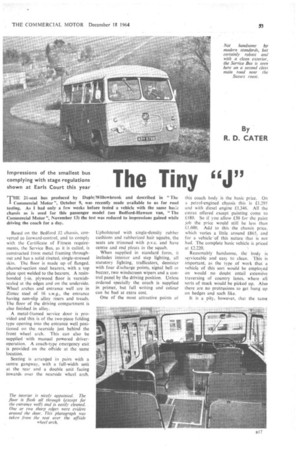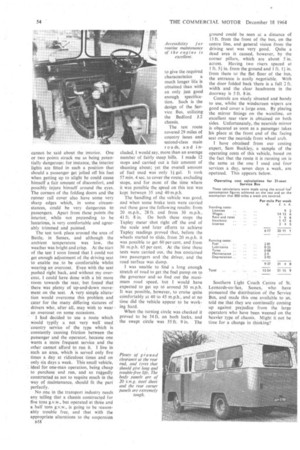The Tiny
Page 55

Page 56

If you've noticed an error in this article please click here to report it so we can fix it.
j99 THE 21-seat bus produced by Duple/Willowbrookand described in " The
Commercial Motor ", October 9, was recently made available to us for road testing. As 1 had only a few weeks before tested a vehicle with the same has*.c chassis as is used for this passenger model (see Redford-Hawson van, "The Commercial Motor ", November 13) the test was reduced to impressions gained while driving the coach for a day.
Based on the Bedford J2 chassis, converted to forward-control, and to comply with the certificate of Fitness requirements, the Service Bus, as it is called, is constructed from metal framing throughout and has a solid riveted, single-stressed skin. The floor is made up of flanged, channel-section steel bearers, with a top plate spot welded to the bearers. A resinbonded 4-in, plywood floor is varnishsealed at the edges and on the underside. Wheel arches and entrance well are in Zintec steel of 16 s.w.g., the entrance having non-slip alloy risers and treads. The floor of the driving compartment is also finished in alloy.
A metal-framed service door is provided and this is of the two-piece folding type opening into the entrance well positioned on the. nearside just behind the front wheel arch. This can also be supplied with manual powered driveroperation. A coach-type emergency exit is provided on the offside at the same location.
Seating is arranged in pairs with a centre gangway, with a full-width unit at the rear and a double unit facing inwardsover the nearside wheel arch. Upholstered with single-density rubber cushions and rubberized hair squabs, the seats are trimmed with p.v.c. and have centre and end pleats in the squab.
When supplied in standard form, it includes interior and step lighting, all statutory lighting, trafficators, demister with four d:scharge points, signal bell or buzzer, two windscreen wipers and a control panel by the driving position. Unless ordered specially the coach is supplied in primer, but full writing and colour can be had at extra cost.
One of the most attractive points of this coach body is the basic price. On a petrol-engined chassis this is £1,295 and with diesel engine £1,346. Al] the extras offered except painting come to £180. So if you allow £50 for the paint job the price would still be less than £1,600. Add to this the chassis, price. which varies a little around £865. and for a vehicle•of this nature that is not bad. The complete basic vehicle is priced at £2,220.
Reasonably handsome, the body is serviceable and easy to clean. This is important, as the type of work that a vehicle of this sort would be employ ed on would no doubt entail extensive traversing of country lanes, where all sorts of muck would be picked up. Also there are no protrusions to get hung up on hedges and such like.
It is a pity, however, that the same cannot be said about the interior. One or two points struck me as being potentially dangerous: for instance, the interior lights are fitted in such a position that should a passenger get jolted off his feet when getting up to alight he could cause himself a fair amount of discomfort, and possibly injure himself around the eyes. The corners of the folding doors and the runner rail cover also have some very sharp edges which, in some circumstances, could be very dangerous to passengers. Apart from these points the interior, while not pretending to be luxurious, is very comfortable and agreeably trimmed and painted.
The test took place around the area of Battle, in Sussex, and although the ambient temperature was low, the weather was bright and crisp. At the start of the test I soon found that I could not get enough adjustment of the driving seat to enable me to be comfortable whilst wearing an overcoat. Even with the seat pushed right back, and without my overcoat, I could have done with a bit more room towards the rear, but found that there was plenty of up-and-down movement on the seat. A very simple alteration would overcome this problem and cater for the many differing statures of drivers who, after all, may wish to wear an overcoat on some occasions.
I had decided to use a route which would typify a not very well used country service of the type which is constantly causing friction between the passenger and the operator, because one wants a more frequent service and the other cannot afford to run it. I live in such an area, which is served only five times a day at ridiculous times and on only six days a week. This small vehicle, ideal for one-man operation, being cheap to purchase and run, and so ruggedly constructed as not to require much in the way of maintenance, should fit the part perfectly.
No one in the transport industry needs any, telling that a chassis constructed for five tons g.v.w., but operated at three and a half tons g.v.w., is going to be reasonably trouble free, and that with the appropriate alterations to the suspension
n18 to give the required
characteristics a much longer life is obtained than with an only just good enough specification. Such is the design of the Service Bus, utilizing the Bedford J.2 chassis.
The test route covered 29 miles of country lanes and second-class main roads, and included, 1 would say, more than an average number of fairly steep hills. I made 12 stops and carried out a fair amount of shunting about; yet the overall amount of fuel used was only 11 gal. It took 57 min. 4 sec. to cover the route, excluding stops, and for most of the time where it was possible the speed on this test was kept between 35 and 40 m.p.h.
The handling of the vehicle was good, and when some brake tests were carried out these gave the following results: from 20 m.p.h., 28 ft. and from 30 m.p.h., 41 ft. 8 in. On both these stops the Tapley meter shot right off the end of the scale and later efforts to achieve Tapley readings proved that, before the wheels started to slide, from 20 m.p.h. it was possible to get 60 per cent, and from 30 m.p.h. 65 per cent. At the time these tests were carried out, the bus contained two passengers and the driver, and the road surface was damp.
was unable to find a long enough stretch of road to get the fuel pump on to the governor and so find out the maximum road speed, but I would have expected to get up tei around 50 m.p.h. It was possible, however, to cruise quite comfortably at 40 to 45 m.p.h., and at no time did the vehicle appear to be working hard.
When the turning circle was .checked it proved to be 54 ft. on both locks, and the swept circle was 55 ft. 9 in. The ground could be seen at a distance of 13 ft. from the front of the bus, on the centre line, and general vision from the driving seat was very good. Quite a dead area is caused, however, by the corner pillars, which are about 5 in. across. Having two risers spaced at 1 ft. 51 in. from the ground and 1 ft_ 11 in. from there to' the flat floor of the bus, the entrance is easily negotiable. With the door folded back 'there is a full 2 ft. width and the clear headroom in the doorway is 5 ft. 8 in.
Controls are nicely situated and handy to use, whilst the windscreen wipers are good and cover a large area. By placing the mirror fittings on the waistline, an excellent rear view is obtained on both sides. Unfortunately, the nearside mirror is obscured as soon as a passenger takes his place at the front end of the facing seat over the nearside front wheel arch.
I have obtained from our costing expert, Sam Buckley, a sample of the operating costs of this vehicle, based on the fact that the route it is running on is the same as the one I used and four services a day, seven days a week, are operated. This appears below.
Southern Light Coach Centre of St. Leonards-on-Sea, Sussex, who have pioneered the distribution of the Service Bus, and made this one available to us, told me that they are continually coming up against prejudice from the large operators who have been weened on the heavier type of chassis. Might it not be time for a change in thinking?








































































































